17.01.2005
Mark DVORETSKY. EXCHANGE OF QUEENS. Part 3.
SELECTION OF EXCHANGE VERSION
At the lecture, which was delivered in 1990 at the first session of the School of Yusupov-Dvoretsky for gifted young chess players, master Alexei Kosikov wittily remarked: "Any exchange in a chess game is as if a bargain. You offer your goods and other goods are offered to you, and each party is striving to derive a benefit". It often makes sense to bargain in order to have the most favourable for you version of exchange.
Tukmakov – G.Kuzmin
Zonal tournament, Yerevan 1982
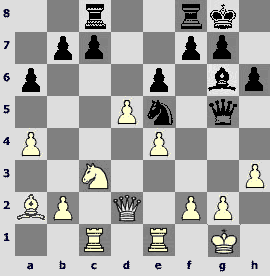
1.?
The danger of check by a knight on f3; it'll come also to 21.¦e3??. A tense variant 21.f4?! ¤f3+ 22.ўf2 ¤:d2 23.fgedresults in the acceptable for Black ending (24.¤:d5 ¤:e4+; 24.Ґ:d5 c6; 24.ed ¦fe8). Incaseof 21.Ј:g5?! hga sacrifice of exchange 22.de ¤d3 23.¤d5 ўh7 is disputable, and 22.¦ed1 will be met by a simple 22...¦fe8 23.de fe (with subsequent ўf7-e7). The backbone of Black's defence is an excellently disposed in the centre knight е5, and it's not an easy task to drive it away from there because the pawn g5 impedes the move f2-f4.
21.Јd2-e3!
This simple move solves all the problems. Vladimir Tukmakov has defended himself against the knight fork and prepared f2-f4. For example: 21...£:e3 22.¦:e3 ¦fe8 23.f4 ¤d7 24.de fe 25.¦d1 (25.e5) 25...¤f8 26.¦ed3±.
21...£e7 22.f4 ¤d7 23.e5 ¦fd8 24.¦ed1 ¤f8 25.¦d4 h5 26.¦cd1 ¥f5 27.a5!. White has an obvious positional advantage, from which he gradually benefits.
Beliavsky – Chernin
Interzonal tournament, Tunis 1985
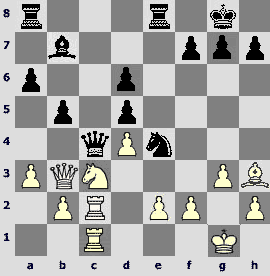
1.?
In case of 21.Ј:с4 dсBlack would have a rather good position.
21.Јb3-b4!
To 21...¤:с3 it's possible to respond both 22.Ј:c3 (22...Ј:c3 23.¦:c3 ¦:e2? 24.¦c7 ¦b8 25.¦:b7 lose immediately) and 22.¦:с3 Ј:е2 23.¦с7 ¦ab8 24.Ј:d6 Ј:b2 25.Јf4 ¦f8 26.Ґe6!. Black has a hard ending after 21...Ј:b4 22.аb ¤f6 23.е3 ¦е7 24.¤е2 g5 25.Ґс8!.
21...а5!? 22.Ј:b5 ¤:с3 23.Ј:с4 dс 24.bс ¦аb8. If 24...Ґe4, then 25.¦d2 ¦ab8 26.d5 ¦b3 27.a4 ¦e5 28.¦d4, but not 25.¦b2 ¦ab8 (Beliavsky).
25.Ґd7!(having moved a bishop on а4, Alexander Beliavsky impedes intrusion of the opponent's rook on b3) 25...¦е7 26.Ґа4 Ґd5 27.g4!. Qualified play! In case of 27.f3?! Black would respond 27...f5! (in essence we see the same way of strengthening of the central piece as in the previous example – in the variant 21.Ј:g5?!). And now, in order to impede f2-f3 and e2-e4, the opponent will have to allow opening of the file "g", which will be occupied by the white rook.
27...g6 28.f3 (not 28.g5 h6!) 28...f5 29.gfgf 30.ўf2 ўf7 31.ўg3 (centeralization of the king) 31...ўf6 32.ўf4 Ґf7 33.¦g1 Ґg6. As usual the transition into the rook ending promised more practical chances for escape: 33...Ґe8!? 34.Ґ:e8 ¦:e8. Beliavskyanalyzes 35.¦g5?, overlooking 35...¦e4+!. Instead I can propose, for example, 35.¦g2!? (planning a3-a4, h2-h4, etc.) 35...a4 (35...¦b8 36.¦g5) 36.¦b2!? (36.h4) 36...¦e3 37.¦b6 ¦:c3 38.d5 with dangerous attack.
34.h4, and White made use of the extra pawn.
Mering – Plachetka
Srbske-Pleso 1978
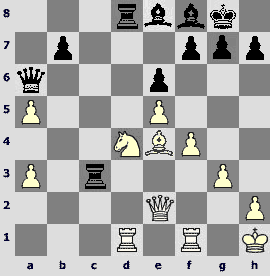
1...?
30...Ј:e2? 31.¤:e2 ¦:d1 32.¦:d1 ¦e3?! Doesn't work in view of 33.¥:b7! ¦:e2 34.a6 ¥c5 35.¦d8ќ.
A sacrifice of the queen is dubious: 30...¦:d4? 31.Ј:a6 ¦:e4. The opponent can either play more reliably: 32.Јa8 (the best thing to do for Black in this case is to force a draw by 32...¦e2! 33.Ј:e8 ¦cc2), or to struggle for a win in a variant 32.Јb6 ¦e2 (32...Ґc6 33.ўg1 with the danger of ¦d8) 33.¦f2 ¦:f2 34.Ј:f2 Ґc6+ 35.ўg1 h5 36.Јb2.
30. . . . Јa6-c4!°
In such a way Black achieves a material advantage. For example: 31.Ґd3 Ј:d4 32.Ґ:h7+ ў:h7 33.¦:d4 ¦:d4°.
31.Ј:c4 ¦:c4 32.Ґ:h7+?(time-trouble convulsions, but even 32.Ґ:b7 ¦c:d4 33.¦:d4 ¦:d4 34.a6 ¦a4 35.¦b1 ¦:a3 are hopeless) 32...ў:h7 33.¤:e6 fe 34.¦:d8 Ґc6+. White resigned.
Benko – Damjanovic
Monte Carlo 1968
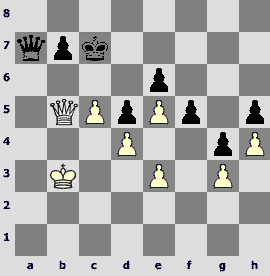
1.
47.Јe8 Јa1 48.Јe7+ ўb8= bring nothing. Pal Benko tries out his only practical chance for a win.
47.Јa4 Ј:a4+?. The exchange of queens should have been made in another way: 47...Јa6! 48.Ј:a6 ba 49.ўb4 ўc6 50.ўa5 ўb7 51.c6+ ўc7! 52.ў:a6 ў:c6=. AndnowBlackgetsinto zugzwang andloses.
48.ў:a4 ўd7 49.ўb4!(zugzwang) 49...ўd8 (49...ўc6 50.ўa5! ўc7 51.ўb5 couldn't change anything) 50.ўa5! ўd7 51.ўb6 ўc8 52.c6 ўb8 53.ўc5! (but certainly not 53.cb?? f4=) Black resigned.
IMPROVEMENT OF PAWN STRUCTURE
Sometimes a desire to correct defects in one's own pawn disposition gives an impulse to exchange of queens.
Fedorovich – Miles
Lon-Pain 1980
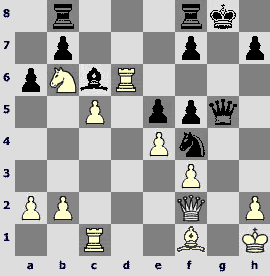
1.?
23.Јf2-g3!
Exchange of queens will permit to drive away the knight from the strong square f4.
23. . . . Јg5:g3
Black has a right todecline the proposal by playing 23...f6. The point is that 24.¦:f6?!, naturally suggesting itself, promises no advantage: 24...Ј:g3 25.¦:f8+ ¦:f8 26.hg ¤h5 27.ўh2 fe. But it's possible to force an exchange of the dangerous bishop c6 by playing 24.¤d7! (with the danger of 25.¤:f6+) 24...Ґ:d7 25.¦:d7±.
24.h2:g3 ¤f4-h5
25.¢h1-h2 f5:e4
26.f3:e4
The position is obviously in White's favour. He wants to play 26.Ґ:a6 or 26.Ґe2. The pawn е4 is invulnerable yet: 26...Ґ:e4? 27.¤d7.
26...ўg7 (to get the square f6 for a knight) 27.Ґ:a6 ¤f6 28.Ґd3 ¤e8 (28...Ґ:e4 29.¦:f6) 29.¦d5! Ґ:d5 (29...¤f6!?) 30.ed ¦d8 31.Ґf5! (31.d6? ¤:d6) 31...¤f6 32.d6, andWhitewon.
Lalic – Hoi
Olympiad, Manila 1992
1.d4 g6 2.e4 Ґg7 3.¤c3 d6 4.Ґe3 ¤f6 5.Јd2 ¤c6 6.f3 0-0 7.0-0-0 e5 8.d5 ¤d4 9.¤ge2 c5 10.dcbc 11.¤:d4 ed 12.Ґ:d4 Ґe6 13.h4 Јa5?.The mistake, resembling the one, which was made by Kamsky against Anand in the above considered example. He had to choose between 13...¦b8 and 13...c5 14.Ґe3 Јa5.
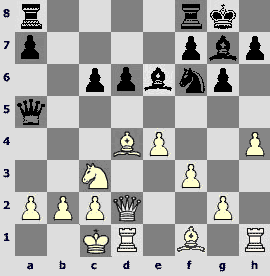
1.?
14.Јd2-g5!
Black is a pawn down, that's why an exchange of queens, especially in such a situation, with the pawn getting on g5, is disadvantageous for him. But a retreat of the queen is also not very attractive.
14...Јd8 15.e5 ¤h5. Alternatives are not better: 15...h6 16.ef! hg 17.fg ¦e8 18.¤e4, or 15...de 16.Ґ:e5 ¤d5 17.Ј:d8.
16.ed Ґ:d4 17.¦:d4 Јb6 18.Јe5! ¦ae8 19.¤a4 Јb8 20.Ґd3 Ґd5 21.Јh2, and White won.
Huebner – Wockenfuss
Bundesliga 1985

1.?
It's a good plan to prepare the move f2-f3. After 19.ўh1 ¦dg8 (19...¦hg8!?) 20.f3 20...¤e3 is tempting counting on 21.Ґf2? d4! (the danger of a capture on h5 with a check). However a modest move 21.Ґh2! nails down the advantage of White: the queen will jump out on f4 after retreating of the knight. Probably it's better for Black to part from the pawn: 20...¤e5, keeping the defensible position.
Robert Huebner has found a more convincing decision: moving the queen on b4.
19.Јd2-f4! e6-e5
20.Јf4-b4!±
After the exchange of queens Black has very hard ending, and in case of 2...Јc7!? 3.¦ab1 the queen on b4 sharply increases the attacking possibilities of White.
20...Ј:b4 21.aba6 22.¦a5 Ґe6. A piece of good advice is valuable here: if 22...Ґc6, then 23.Ґf5+ Ґd7 24.¦c5+ ўb8 25.Ґ:d7 ¦:d7 26.f3 ¤h6 27.¦:e5!.
23.¥h4 ¦df8 24.f3 ¤h6 25.b5 ¦hg8 (25...ab 26.¥:f6!) 26.baba 27.¦:a6. Black resigned.
Janovsky – Bernstein
Petersburg 1914
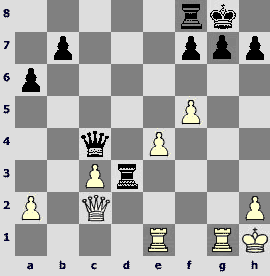
1.
This position was analyzed many years ago in the excellent article of Paul Keres "Defence of hard positions". I'll reproduce his train of thoughts.
White has a worse position in view of vulnerability of his pawns and activity of the opponent's pieces. An attack along the line "g" has no chances for success because it's necessary to play e4-e5 to support it, but then the diagonal h1-a8 becomes open. That's why it's necessary to accept the inevitability of the exchange of queens and to try to realize the most advantageous version of it.
The strongest move in opinion of Keres was 25.Јg2!. To 25...g6 26.e5 with the dangers of 27.e6 and 27.Ј:b7 is unpleasant. That's why Black plays 25...Ј:c3 26.e5 Јc6 (to 26...g6 the most simple is 27.Ј:b7 –indicated by Keres 28.e6 is weaker because of 28...¦d2 29.Ј:b7 Јc2 30.¦g2 ¦:g2 31.Ј:g2 Ј:f5 32.e7 ¦e8) 27.Ј:c6! (but not 27.¦e4? g6 28.e6 ¦d2! – Tarrash) 27...bc, and then either 28.f6 g6 29.e6 fe 30.¦:e6, or 28.¦g3!? with a good chance for a draw.
As 25.¦g3? ¦fd8 is disadvantageous for White, then the only alternative is the continuation which he chose in the game:
25.e5 Јc6+
If now 26.Јg2, then 26...¦:c3, and 27.¦e4 g6 28.e6 ¦c2 bring nothing, and in case of the exchange of queens Black takes a piece on с6 by the rook, keeping the better pawn structure as compared with the variant 25.Јg2!. For that reason Keres considers the move e4-e5 to be not correct.
To consider the logic of the GM as the impeccable one, it's necessary to confirm the hopelessness of White's position after 26.¦g2 ¦fd8!. It seems to me that it was that moment when David Janovsky made the decisive mistake. He chose 27.Јf2? and lost without a struggle: 27...¦d2 (27...¦d1 with the danger of 28...Ј:c3 isn't less strong) 28.Јg3 ¦:g2 29.Ј:g2 Ј:c3 30.Јg3 ¦d3 31.Јh4 ¦d4 32.Јg3 Јc6+ 33.ўg1 h5 34.h3 ¦e4 35.e6 fe 36.feЈ:e6 37.¦f1 ¦e3 38.¦f3 ¦e1+ 39.ўg2 Ј:a2+. White resigned.
However it's unclear, how to rebut a direct 27.e6! fe 28.fe ¦d2 29.Јe4. In the variant 29...¦d1 30.e7 ¦e8 31.Јe5 ¦:e1+ 32.Ј:e1 no way to win the pawn e7 is seen, and without that Black has nothing to count on. In the rook ending that arises in case of 29...Ј:e4 30.¦:e4 ¦d1+ 31.¦g1 ¦:g1+ 32.ў:g1 White escapes move in move: 32...¦e8 (32...¦d1+ 33.ўf2 ўf8 34.¦f4+) 33.ўf2 g6 (33...ўf8 34.¦f4+) 34.ўe3 ўg7 35.ўd4 ўf6 36.ўd5 ¦d8+ 37.ўc5 ўe7 38.ўb6.
NON-STANDARD EXCHANGE (with doubling of pawns)
A concern for a pawn structure is certainly not the only positional problem to solve during the struggle. On the contrary it's sometimes necessary to violate "Filidor's" principle of the compactness of the pawn chain for the achievement of more important aims. However such situations arise not very often, that's why the exchanges, concerned with damaging of one's own pawns, usually produce a strong aesthetic impression because of their originality.
Nikolic – Mirumian
Olympiad, Yerevan 1996
1.¤f3 ¤f6 2.c4 g6 3.b3 Ґg7 4.Ґb2 0-0 5.g3 c5 6.Ґg2 ¤c6 7.0-0 d6 8.d4 cd 9.¤:d4 Ґd7 10.e3 ¦c8 11.¤c3 a6 12.¦c1 ¤:d4 13.Ј:d4 Ґc6 14.Јd3 (14.¤d5) 14...¤d7 15.¦fd1 Јa5 16.Јe2 ¦fe8 17.Ґh3 ¤e5 18.e4 Ґd7 19.Ґ:d7 ¤:d7 20.a3?!
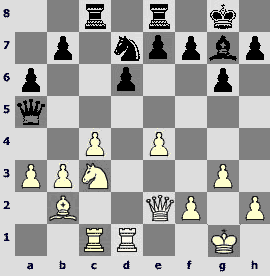
1...?
20. . . . Јa5-h5!!
White was planning 21.b4 (with 22.c5 to follow) or 21.¤d5. Exchanging queens, Black upsets his plans and in his turn issues a threat of attacking the opponent's pawns by the move ¤c5.
21.Јe2:h5
To 21.f3 there follows 21...¤c5 (21...b5 22.cb ab 23.¦d5 are worse) 22.¦d5 Јh6і.
21. . . . g6:h5
Now it's not easy to choose the appropriate way to parry 22...¤c5. Probably, it should have been played 22.¦c2! ¤c5 23.b4 ¤e6 (23...Ґ:c3 24.bc! Ґ:b2 25.cd! ed 26.¦:b2=) 24.¤a4 b5 25.Ґ:g7 ў:g7 26.¤b2 ¤g5 (26...¦c6!?) 27.¦e2!? (27.¦d5?! ¤:e4 28.¦:h5 e5! 29.f3 ўg6! 30.¦h4 ¤g5µ) 27...bc 28.f4 c3 (28...¤e6 29.¦c2) 29.fgcb 30.¦:b2, and defects of the pawn structure of White, probably, would be compensated by the capabilities of counter-play at the queen side (¦d1-d5-a5).
22.Ґa1?! ¤c5 23.¦b1 (23.b4?? ¤b3 24.¦c2 ¤:a1 25.¦:a1 ¦:c4°) 23...Ґ:c3 24.Ґ:c3 ¤:e4µ 25.Ґa1 ¦c6 26.¦d4 f5 27.¦bd1 ўf7 28.f3 ¤c5 29.¦b1 ¦ec8 30.ўg2 ¦b6! 31.b4 ¤e6 32.¦d5 ¦:c4 33.¦:f5+ ўg6 34.¦d5 ¦c2+ 35.ўh1 ¤g5° 36.¦d3 ¦bc6 37.Ґd4 ¦e2 38.h4 ¤f7 39.ўg1 ¦cc2 40.ўf1 ¤h6! 41.¦e1 ¤f5 42.¦:e2 ¤:g3+ 43.ўe1 ¦:e2+ 44.ўd1 ¦h2 45.¦c3 ¦:h4 46.Ґf2 ¦h1+ 47.ўd2 ¤f5.White resigned.
Kholmov – Suetin
Championship of the USSR, Leningrad 1963
1.e4 c5 2.¤f3 ¤c6 3.d4 cd 4.¤:d4 e6 5.¤c3 Јc7 6.Ґe2 a6 7.a3 b5 8.¤:c6 dc (8...Ј:c6!?) 9.0-0 e5 10.Јd3! (10.Ґg4 ¤f6=) 10...¤e7! (10...¤f6 11.Јg3) 11.a4 b4 12.¤b1 ¤g6 13.Јb3 Ґc5 14.Ґc4 0-0 15.Ґe3 Јe7 16.¤d2 a5 17.¦ad1 ¤f4 18.Ґ:c5 Ј:c5
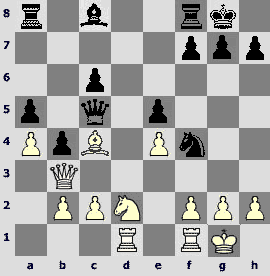
1.?
It's not easy for White to deploy his forces. It's unsuccessful, for example, 19.g3? ¤h3+ 20.ўg2 ¤g5 with the danger of 21...Ґh3+.
It's necessary to exchange the black queen or to drive it away from the strong square с5.
19.Јb3-e3!
If 19...Ј:e3 20.fe ¤e6 (in case of 20...¤g6 21.¤b3 or 21.¤f3 the black knight is out of play), then 21.¤f3 Ґa6 22.Ґ:a6 ¦:a6 23.¤:e5 ¤c5 24.¤d7!±.
19...¤e6 20.Ґ:e6 Ј:e3 21.Ґ:f7+ ¦:f7 22.fe± aren't better (Black's pawn е5 is weak).
And in case of the retreat of the queen White, having played 20.¤b3, starts a struggle for the square с5 and the line "d".
19...Јe7 20.¤b3 Ґe6 21.Ґ:e6 ¤:e6 22.¦d2 c5. Mass exchanges did not make the position of Black better: 22...¦fd8 23.¦fd1 ¦:d2 24.¦:d2 ¦d8 25.¦:d8+ Ј:d8 26.Јd3!±.
23.¦d5 c4(23...¤d4 24.¦:c5 ¤:b3 25.cb±)24.¤c5 ¦fc8 25.¤:e6 Ј:e6 26.¦fd1 Јc6(26...Јe7 27.Јb6!)27.¦b5 c3?! 28.b3 ¦d8 29.¦bd5! ¦:d5 (29...Јc7? 30.Јa7!) 30.¦:d5. The control over the only open line provided to White a great advantage, which Ratmir Kholmov has gradually used.
Smyslov – Tal
Challenger's tournament, Yugoslavia 1959
1.e4 c5 2.¤f3 d6 3.d4 cd 4.¤:d4 ¤f6 5.¤c3 a6 6.Ґe2 e5 7.¤b3 Ґe7 8.0-0 0-0 9.Ґe3Јc7?! (9...Ґe6 is more accurate according to the theory) 10.a4 Ґe6 (10...b6) 11.a5 Јc6
In the famous game Geller – Fischer (Challenger's tournament, Curacao 1962) 11...¤bd7 12.¤d5 ¤:d5 13.edҐf5 14.c4 Ґg6?! was played (as Edmar Mednis noted, 14...¦ac8 15.¦c1 Јd8 16.Јd2 h6Іwith the idea Ґg5 is better) 15.¦c1 ¤c5? (15...f5?! 16.f4!; 15...¦ac8) 16.¤:c5 dc 17.b4!±.
12.Ґf3. Certainly, not 12.f3? d5. Isaac Boleslavsky recommended 12.Јd3!? ¦d8 13.¦fd1 ¤bd7 14.¤d5.
12...¤bd7 13.¤d5! Ґ:d5 14.ed Јb5. In the game Stein – Boleslavsky (team championship of the USSR, Grozny 1969) Black tried 14...Јc4 15.¤d2 Јb5 (15...Јh4 16.g3 Јh3 17.¦a4!?), but after 16.Јb1! with the idea 17.c4 ran against serious difficulties.
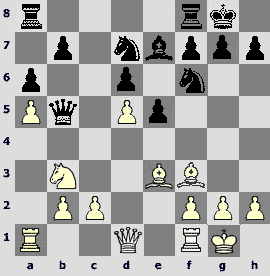
1.?
15.Јd1-d3!!
"It's a correct interpretation of the position. The exchange of queens on d3 is advantageous for White, as he gets opportunities to use the rook along the file "с". Having advantage of two bishops and strong pressure at the queen side, he can take success for granted in the ending" (Smyslov).
15...¦fc8 16.¦fc1 Ј:d3?!After the exchange the advantage of White does not admit of doubt. 16...Јb4 17.Ґd2!? is preferable (17.c4? e4! 18.Ґ:e4 ¤e5 is unsuccessful; 17.¤d2 ¤c5 leads to equality, however 17.Ґe2!? deserves attention) 17...Јh4І.
17.cdg6. As Vassily Smyslov noted, 17...¤c5? 18.¤:c5 dc 19.d6! was losing. In the opinion of Artur Yusupov it was worthy to think about 17...ўf8!? 18.¦c3 ўe8 19.¦ac1 ўd8.
18.¦c3 ¦:c3 19.bc ¦c8 20.c4 e4! (otherwise White, having played 21.¦b1, would press on b7) 21.de ¦:c4 22.¤d2 ¦c2 23.Ґd1 ¦c3 24.ўf1 ¤c5 25.Ґd4 ¦d3 26.Ґ:c5 dc 27.ўe2 ¦:d2+ (27...¦d4 28.f3 is also cheerless) 28.ў:d2 ¤:e4+ 29.ўc2 ¤d6 (29...¤:f2? 30.Ґf3 f5 31.¦b1 is bad) 30.Ґe2 Ґf6 31.¦b1 ўf8 (31...Ґd8? 32.Ґ:a6! ba 33.¦b8) 32.ўb3 ўe7 (it's better to play 32...Ґd4 33.f4 h5 and to put the king on f6) 33.Ґd3 ўd7 34.f4!, and White has gradually made use of his extra exchange.
Smejkal – Ambroz
Championship of Czechoslovakia 1978
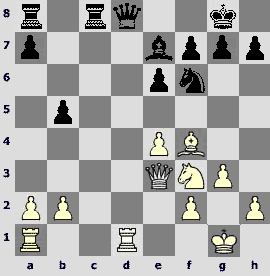
1...?
21. . . . Јd8-b6!і
Proposing an exchange of queens, Black endangers the pawn е4. Besides, in case of 22.Ј:b6 ab the line "а" becomes open.
After 22.Јe2 Black had to choose the most precise of two ways to attack the pawn е4, but his guess was beside the mark.
22...Јb7?!. Now White exchanges the knight f6, providing safety of the central pawn. And in case of 22...¦c4! it, most likely, had to be advanced, ceding the square d5 to the knight.
23.Ґg5! h6 24.Ґ:f6 Ґ:f6 25.¦ac1, and the play became equal.
In conclusion I suggest that you take a little test: six exercises somehow concerned with the problem of exchange of queens. I hope that after studying the article the task will seem to be easy for you.
Exercises
1
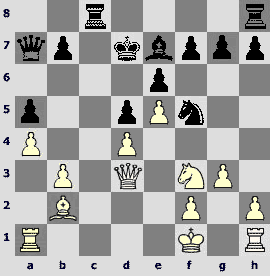
1...?
2
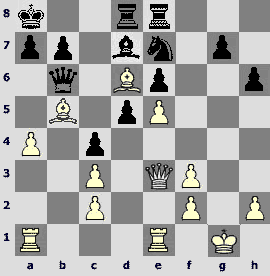
1...?
3
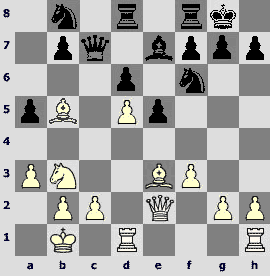
1.?
4
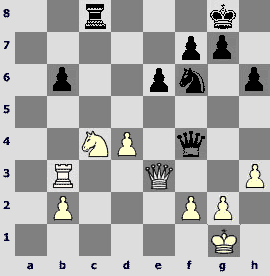
1...?
5
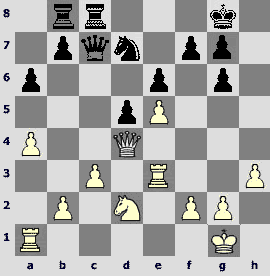
1...?
6
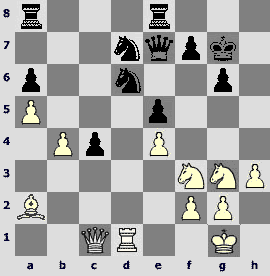
1.?
Solutions
1. Paulsen – Tarrash, Nuernberg 1888
19...Јa6! 20.Ј:a6 (20.ўe2?? ¦c2+) 20...ba
A bad bishop b2, weakness of the pawns b3 and d4 determine a great advantage of Black.
21.ўg2 (21.¤e1 ¦b8 22.Ґc3 ¦:b3 23.Ґ:a5 ¤:d4°) 21...¦c2 22.Ґc1 ¦b8 23.¦b1 ¦c3 24.Ґd2 ¦c:b3 25.¦:b3 ¦:b3 26.Ґ:a5 ¦b2! 27.Ґd2 Ґb4!, and Black won.
2. Stefansson – Domatov, New York 1989
An exchange of queens both on е3 (pawn structure of White at the queen side is improving) and on b6 (the queen side of Black is weakening sharply) is advantageous for White.
An interesting attempt 21...d4?! 22.Ј:d4 Ј:d4 23.cd ¤f5 is justified in case of 24.Ґc7 ¤:d4 25.¦ed1 Ґ:b5›, however White has a bit better chances after 24.c3 ¤:d6 25.ed Ґ:b5 26.ab ¦:d6 27.¦a4.
The strongest move is 21...Јa5!. Having kept an advantageous for him pawn structure, Black gets an advantage. For example: 22.Ґb4 (preferable is 22.Јc5!? ¦c8 23.Јb4і) 22...Јc7 23.Ґd6 Јc8µ (with 24...¤f5 to follow).
In the game there was 21...Ј:e3?! 22.feҐc6 (22...Ґ:b5 23.abb6?! 24.Ґc7 or 24...¤c8 24.Ґc7!? ¦d7 25.b6) 23.Ґ:c6 ¤:c6 24.ўf2 ¤e7 25.e4! de 26.feІ.
3. Sax – Quinteros, Interzonal tournament, Moscow 1982
19.Јc4!± The black queen is essentially the only defender of the queen side and it's advantageous to exchange it.
19...Ј:c4 20.Ґ:c4 ¦c8 21.Ґb5 (another way is: 21.¤:a5! Ґd8 22.¤:b7 ¦:c4 23.¤:d6±) 21...Ґd8 22.g4 ¤fd7 23.¤d2 Ґb6 24.Ґg5 (the danger of 25.Ґe7 and 25.¤c4).
Exchange of bishops 24.Ґ:b6?! ¤:b6 25.¤e4 ¦fd8 (with the idea ¦c7, ¤c8) would permit Black to strengthen his position. And the other version of exchange: 24.¦he1!? Ґ:e3 (24...¦fd8 25.¤c4ќ) 25.¦:e3 ¤b6 26.¤e4 ¦fd8 27.¦b3! ¦c7 28.Ґc6!?± (28.Ґa6) was rather strong.
24...Ґd8 (Black has a hard position also in case of 24...f6 25.Ґh4, for example: 25...¦c5 26.c4 and 27.¤e4; 25...g5 26.Ґe1 and 27.¤c4; 25...Ґc7 26.¤c4, planning 27.Ґe1 b6 28.b4±) 25.Ґ:d8 ¦f:d8 26.¤c4 (there are two pawns en prise at once) 26...¦c7 27.¤:d6 ¤f6 28.¤f5 ¦c5 29.c4, and White won.
4. Knaak – Inkev, the match GDR – Bulgaria 1982
At any version of exchange of queens (33...Ј:e3; 33...¤d5; 33...e5; 33...g5!?) White can reckon on equalization. The strongest plan is to attack the king.
33...Јf5! (with the danger 34...Јb1+) 34.¤d6 (34.¤d2 ¦c1+ 35.ўh2 ¤d5 or 35...Јc2) 34...Јb1+ 35.ўh2 ¦c1 36.Јd3 ¦h1+ 37.ўg3 Јc1 38.¦c3 (38.Јe3 Јc7 39.Јe5 Ј:d6!) 38...Јg5+ 39.ўf3 Јh5+ (39...Јd5+!? 40.ўe2 g6 with double blow on d6 and g2) 40.ўg3 Јg5+ 41.ўf3 Јh5+ 42.ўg3 g5! 43.Јe3 (43.¦c8+ ўg7 44.¤e8+ ¤:e8 45.¦:e8 Јh4+ 46.ўf3 ¦e1°) 43...g4! 44.¦c8+ ўh7 (44...ўg7 is inaccurate in view of 45.Јe5! ¦:h3+ 46.ўf4) 45.¤e8 ¤:e8 (but not 45...¦:h3+? 46.ghЈ:h3+ 47.ўf4 ¤d5+ 48.ўe5 ¤:e3?! 49.¤f6+ with a checkmate) 46.¦:e8 gh 47.Јe4+ ўg7 48.ghЈ:h3+ 49.ўf4 Јh4+. White resigned.
5. Illescas – Anand, Linares 1994
Later White would start an attack at the king side by means of ¤f3, then either Јh4 and ¤g5, or Јg4 and h4-h5. It's useful to eliminate the eventual danger for the king immediately by forcing the exchange of queens.
22...Јb6!і. It's impossible to avoid an exchange as the pawn b2 is en prise.
23.Ј:b6 ¤:b6 24.h4 (otherwise at some moment it'd be necessary to reckon with g6-g5, g7-g6, ўg7, ¦h8-h4) 24...ўf8 25.g3 ўe7 26.b3?!
The beginning is of doubtful character. The advantage of the Indian grand master's level begins to tell, the opponent does not know the ropes of the arisen ending.
26...¦c7 27.a5 ¤d7 28.c4 ¦bc8 29.ўg2 (after 29.cd ¦c1+ 30.¦:c1 ¦:c1+ 31.ўg2 ed the pawns а5 and е5 arevulnerable) 29...¤b8 30.¦a4?! (the danger of 31.cded 32.e6 and 33.¦g4 is easy to be averted) 30...¦d8 31.f4 ¤c6 32.¦d3 ¦cd7 33.c5 f6 34.¤f3 d4 35.ef+ gf 36.¤d2 e5 37.¤e4 ¦d5 (Black has prepared f6-f5) 38.fe ¦:e5 39.¤d6 ¦:c5 40.¤:b7? ¦c2+. White resigned.
6. Karpov – Spassky, Moscow 1973
32.Јd2? ¦ad8 33.Ј:d6? ¤f8° is a mistake.
32.Јg5!!ќf6?! (32...¦ac8 33.¦:d6 Ј:g5 34.¤:g5 ¤f6 35.¤e2 c3 36.Ґ:f7 is not much better) 33.Јg4 (the danger of 34.¦:d6) 33...ўh7 34.¤h4. Blackresigned – 34...¤f8 35.¤:g6!; 34...¦g835.Ґ:c4 (or right away 35.¦:d6 Ј:d6 36.¤hf5) 35...¦g7 36.¦:d6 Ј:d6 37.¤hf5.
